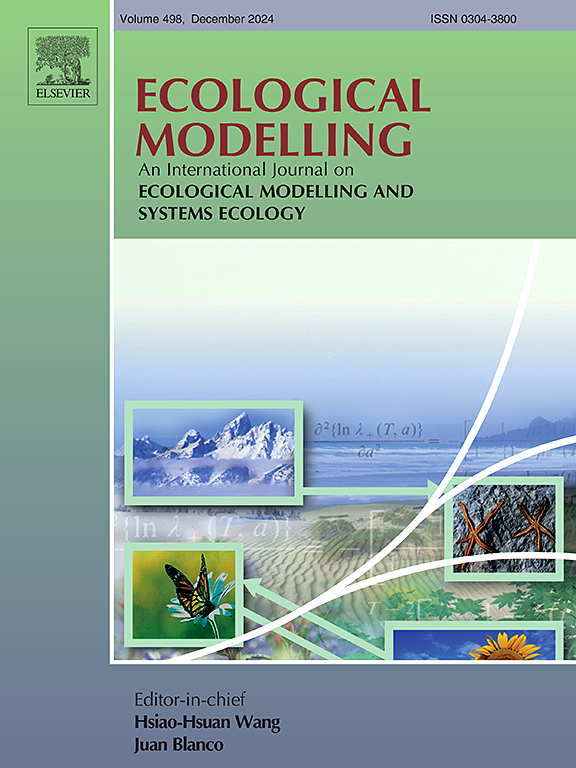底栖大型无脊椎动物对人为压力响应的长期多参数分析,包括评估墨西哥山区河流生态状况的新多度量指数
IF 3.2
3区 环境科学与生态学
Q2 ECOLOGY
引用次数: 0
摘要
评估人为压力(如城市化、农业)对河岸生态系统的影响是其可持续管理的关键。在世界范围内,越来越多地使用基于生物组合的多尺度指数(MMIs)来评估这种压力。它们的成本效益优势和开发的科学严谨性使它们成为生态系统诊断和保护的有效生物指示工具。本研究旨在建立墨西哥盆地的大型底栖无脊椎动物(MIB)的MMI,该MMI是通过对77个地点的多年生河流和泉水取样,在10年的时间里观测到的。从现存的政府地图中确定潜在的地点,然后访问以验证它们的当前状态或存在,并与这些地图记录进行比较。我们从80个生态指标开始,过滤这些指标以消除冗余,评估它们区分保护和退化地点的能力,具有时间稳定性,使用参考地点的MIB指标的显着残差值调整其得分值以适应自然环境梯度。在此基础上,分析了区域尺度和流域尺度上人类活动引起的环境变化的相关程度。最终的MMI是基于5个指标构建的:总丰度、双翅目丰富度、爬行生物丰富度、抓取生物百分比和临时附着生物百分比。该指数在保护地和退化地之间存在显著差异,在局部和流域尺度上对环境变化的响应也存在显著差异。实施的MMI显示了方法上的可复制性、效率和大型无脊椎动物群落在墨西哥和其他水生生态系统受到土地利用变化持续压力的国家用作生物指标的潜力。本文章由计算机程序翻译,如有差异,请以英文原文为准。
A long-term multiparametric analysis of benthic macroinvertebrate responses to anthropogenic stressors, including a novel multimetric index for evaluating the ecological conditions of mountain rivers in Mexico
Assessing the impacts of anthropogenic pressures (e.g., urbanization, agriculture) on riparian ecosystems is key to their sustainable management. The use of multimetric indices (MMIs) based on biological assemblages for assessing such pressures has increased worldwide. Their cost-benefit advantage and the scientific rigor of their development make them efficient bioindication tools for ecosystem diagnosis and conservation. This research aimed to develop an MMI for the Basin of Mexico based on the assemblages of benthic macroinvertebrates (MIB) observed through sampling perennial rivers and springs at 77 sites over a ten-year period. Potential sites were identified from extant government maps and then visited to verify their current state or existence compared to these cartographic records. We began with 80 ecological metrics and filtered these to remove redundancy, evaluating their ability to differentiate between conserved and degraded sites, have temporal stability, adjusting their score values to natural environmental gradients using significant residual values of the MIB metrics at reference sites. Furthermore, the degree of correlation between environmental changes due to anthropogenic activities at the local and catchment scales was assessed. The final MMI was constructed based on five metrics: Total Abundance, Diptera Richness, Crawler Richness, % Scrapers, and % Temporarily Attached Organisms. The index showed significant differences when discriminating between conserved and degraded sites, as well as when responding to environmental changes at the local and catchment scales. The implemented MMI demonstrates methodological replicability, efficiency, and the potential of macroinvertebrate assemblages to be used as bioindicators in Mexico and other countries where aquatic ecosystems are under constant pressures from land-use change.
求助全文
通过发布文献求助,成功后即可免费获取论文全文。
去求助
来源期刊

Ecological Modelling
环境科学-生态学
CiteScore
5.60
自引率
6.50%
发文量
259
审稿时长
69 days
期刊介绍:
The journal is concerned with the use of mathematical models and systems analysis for the description of ecological processes and for the sustainable management of resources. Human activity and well-being are dependent on and integrated with the functioning of ecosystems and the services they provide. We aim to understand these basic ecosystem functions using mathematical and conceptual modelling, systems analysis, thermodynamics, computer simulations, and ecological theory. This leads to a preference for process-based models embedded in theory with explicit causative agents as opposed to strictly statistical or correlative descriptions. These modelling methods can be applied to a wide spectrum of issues ranging from basic ecology to human ecology to socio-ecological systems. The journal welcomes research articles, short communications, review articles, letters to the editor, book reviews, and other communications. The journal also supports the activities of the [International Society of Ecological Modelling (ISEM)](http://www.isemna.org/).
 求助内容:
求助内容: 应助结果提醒方式:
应助结果提醒方式:


